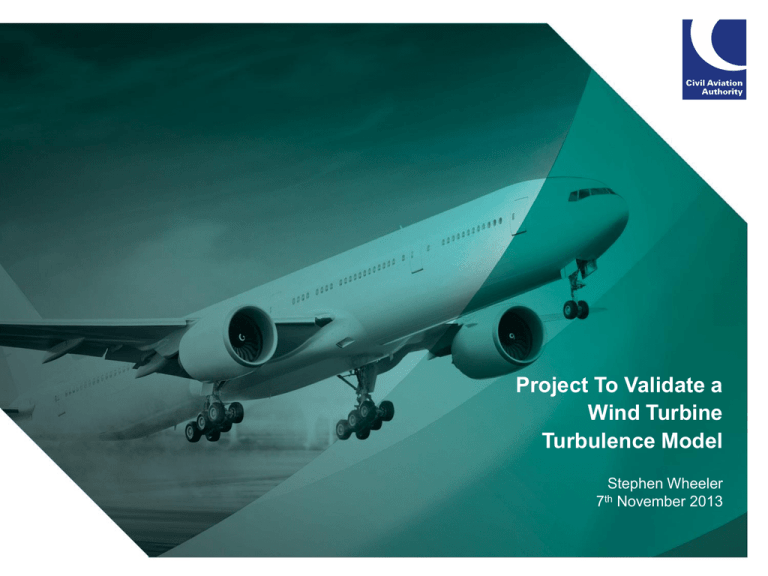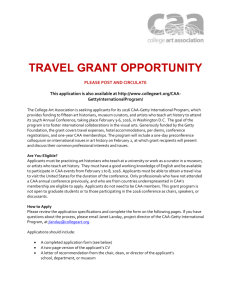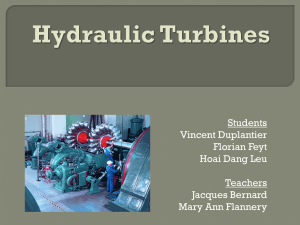document (PDF)
advertisement

Project To Validate a Wind Turbine Turbulence Model Stephen Wheeler November 2013 7th 1 Introduction • The Civil Aviation Authority • The CAA’s Environmental Programme • Presenter • Project Background • Outline Of The Project To Validate a Wind Turbine Turbulence Model • Output • Timelines • Next Steps • Final Message • Any Questions? 2 The Civil Aviation Authority The CAA is the UK's specialist aviation regulator. Its regulatory activities range from making sure that the aviation industry meets the highest technical and operational safety standards to preventing holidaymakers from being stranded abroad or losing money because of tour operator insolvency. 3 CAA Environmental Programme • Is a high level document that outlines the CAA’s environmental objectives until 2016. It can be found at: http://www.caa.co.uk/docs/2248/CAA_and_the Environment_final.pdf • Each area of the CAA has specific environmental objectives within the programme • CAA Environmental Programme areas responsible for this project are: Safety and Airspace Regulation Group - Safety and Standards element of the programme Aerodrome and Air Traffic Standards Division Air Traffic Management Section 4 Presenter Stephen Wheeler Safety and Standards Hotspot Champion Civil Aviation Authority Safety and Airspace Regulation Group Aerodrome and Air Traffic Standards Air Traffic Management Standards Tel: 01293 57 3819 Email: Stephen.wheeler@caa.co.uk 5 Project Background • Why Undertake this Project? Observed rise in the number of aerodromes voicing concerns regarding their perception of the possible effects of wind turbine turbulence on their operations Greater proliferation of wind turbines in more densely populated areas and those areas used by aviation Completion of a Safety Review by the CAA into the establishment of two wind turbines at East Midlands Airport 6 • What are we endeavouring to achieve? To obtain a greater knowledge and provide high quality impartial evidence regarding wind turbine turbulence. The CAA commissioned a project undertaken by Liverpool University - Integrated Simulation of Light Aircraft Encounter With Helicopter and Wind Turbine Wakes An initial element of this wider project resulted in the creation of a model outlining the nature of the turbulence associated with wind turbines Whilst the creation of this model was a step in the right direction, the data would not be able to be released into the public domain and hence used as a resource for wind turbine and aviation industries alike, until validated To ensure the model could be validated as soon as possible and to ensure that the data released was of the highest quality possible it became evident that the use of a LIDAR would be the most efficient and effective method of achieving these objectives Therefore a separate project outside of the original project was needed to validate of the Liverpool University model. 7 Outline Of The Project To Validate a Wind Turbine Turbulence Model • The project consisted and consists of the following stages: Selection of a suitable LiDAR System Request for funding East Midlands Airport – Manchester Airlines Group Selection of a suitable time of year . Fund Management Board - AIFCL– One-off payment. Selection of a suitable location Galion Lidar - Provided by SgurrEnergy, Glasgow. Undertaken after consultation with the Meteorological Office to attain, via historical data, the best time of year to ensure the wind speeds needed to validate the model 8 Installation of the LiDAR at the project site The Galion Lidar is relatively small and mobile (only 83kg) therefore the installation and site calibration time is short i.e. A day or two Turbulence monitoring period LiDAR left in situ for the monitoring process to begin Assessment Liverpool University will complete this aspect of the project Peer of data output review of model This will possibly be undertaken by the Dutch Research Institute – NLR tbc Publication Once the final validated and peer reviewed model is produced the CAA will ensure that its content will be released into the public domain in a format that is usable for both the wind turbine and aviation industries alike 9 Output • What will the project deliver? • An independently commissioned, high quality, fully validated, peer reviewed model, outlining the length and nature of the turbulence associated with wind turbines for a wide variety of wind speeds Where will this be published? Aeronautical Information Publication CAP 764 New guidance for those wishing to undertake renewable developments on or near aerodromes An entry in the Airspace Safety Initiative Local Planning Authority presentation 10 Benefits • Alleviation of the problem of spurious objections to wind farm developments based on the turbulent effects of wind turbines on aerodrome operations • Reduction in the time required by wind turbine developers to assess the nature and effects of any wind farm development on neighbouring aerodromes and those who operate from them • Reduction in project delay times associated with turbulence related concerns raised by aerodromes and those who operate from them • Reduction in the costs associated with delays caused to wind turbine developments by aviation concerns relating to turbulence 11 Timelines • 2013 • May Jun Aug Nov Dec - Project Initiation Galion Lidar selected Funding Agreed With Fund Management Board East Midlands Site Finalised LIDAR Insitu East Midlands Liverpool University Obtain Results 2014 Mar - Liverpool University Finalise Model Apr - Results Peer Reviewed May - Results Published 12 Next Steps • Flights through wind turbine turbulence to find out likely effects? Helicopter Simulated Possibly real Fixed Wing 13 Final Message • Leadership and Part Funding - Aviation Industry - Stephen Wheeler - CAA Project Lead • Project Funding - Wind Industry - Simon Heyes Chairman Fund Management Board • Turbulence Data Assessment and Modelling - Liverpool University - George Barakos – Academic Director School Of Engineering • Project Location - Aviation Industry - East Midlands Airport - Simon Whitby Flight Operations Director/ Mark Chambers - Engineering Manager • Project Equipment - Wind Industry - Galion Lidar- SgurrEnergy - Gordon Mina – Technical Engineer 14 If A Common Problem Presents Itself Collaboration Is The Key To Solving It To The Benefit of All 15 Any Questions? 16











